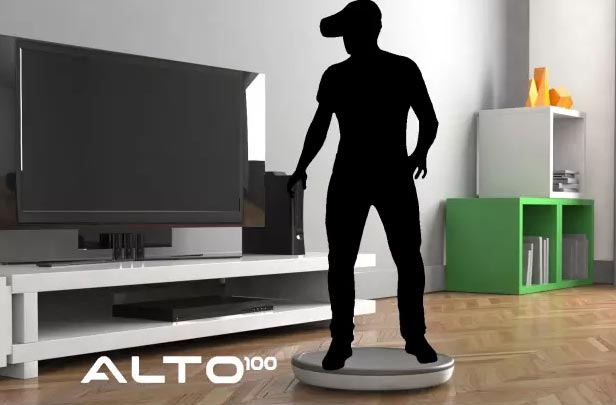Recently, I tried my hand at a hoverboard and discovered that trusting in this moving object below me was an exciting challenge. Then I came across the Alto 100, which uses hoverboard style technology to create a balance board for VR locomotion. Alto is a sleek little pad users stand on and shift their weight around. The Melbourne-based studio behind the Alto, Viso Space, wants to make motion feel effortless and fluid.
VR locomotion is an interesting nut to crack. Free motion is becoming a popular trend for shooter-based games and even some RPGs. You’ll find it in many popular titles. It’s probably the most requested feature I come across when browsing forums. It is also nauseating when done poorly, even with some of our fitness hacks.
The Alto Balance Board wants to solve this interesting challenge with an affordable solution built for the home.
How it Works
The Alto is a people mover in VR, like a virtual surfboard. Moving feels like gliding, but you lean into your movements. Your brain receives the signal you should be moving forward based on how you’re leaning, thus hypothetically removing motion sickness.
It operates on rechargeable double A batteries powered by a 5V PSU and connects to a base device via USB or Bluetooth. You can step on and off as needed to explore the world around you, with haptic feedback beneath your feet to simulate the action of walking. In the team demo, they’ve built in small gradations that the board can simulate that feel like you’re moving across a gravelly surface.
As the board isn’t using pressure sensors, you’re not likely to use this for something like a boxing or fighting game. We envision narrative adventures like Skyrim, where the user would use the Alto to traverse vast stretches of the landscape and then get off to explore individual rooms for loot. Lean on the board, and you move faster or slower depending on your stance. In the video below, the board moves beneath the user’s feet as he changes directions.
Movement in the Alto is a lot like a Segway or a hoverboard, so you cannot rapidly change direction yet. The team is working on a solution to this issue with one solution potentially being the usage of a “handbrake” function.
The size of the device is also interesting to us. At its current scale, it would fit well in spaces not designed for room-scale VR (like apartments). However, those used to room scale might want to move around physically. That could become a tripping hazard if the board isn’t sensed by your base stations and rendered in game.
[youtube https://www.youtube.com/watch?v=ATpPvLE8qys&w=560&h=315]
Current Status
The Alto 100 IndieGoGo has now ended, and all units were shipped. The small hoverboard looks well designed and sturdy enough, but the developers admit there are still kinks to be worked through. That’s why the current iteration is meant for software developers. They anticipate a full consumer launch by the end of 2018, so this isn’t technology that will vanish into the ether if the stars align.
Ultimately, Viso Space hopes that this is the start of a more significant initiative that better simulates the haptics of VR. Ideally, the company wants to make it possible for players to navigate and touch the virtual world with real-world sensations freely.
Final Thoughts
Trying to solve locomotion in VR isn’t crossing new territory, but doing it at this price point makes the project feel ambitious. Most of the treadmill technology we have seen is aimed at arcade operators with vague ideas on becoming consumer friendly. The Alto 100 seems built with the home user in mind.
The missing link at this point is developer support, but the device feels affordable for the experience it offers.
We also speculate that such a device might have some calibration challenges. If you’ve ever spent time in Steam VR calibrating, then you have an idea of the potential for a headache.


